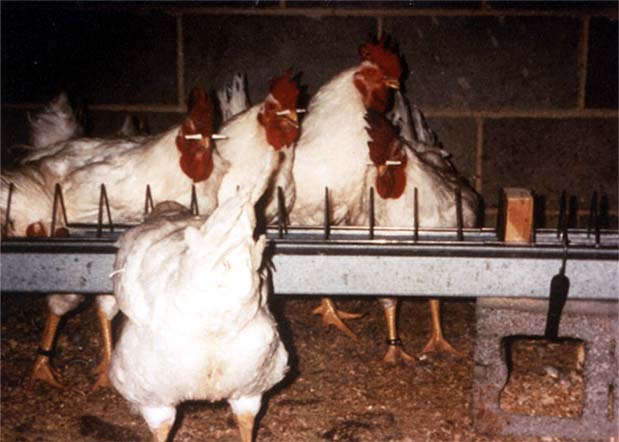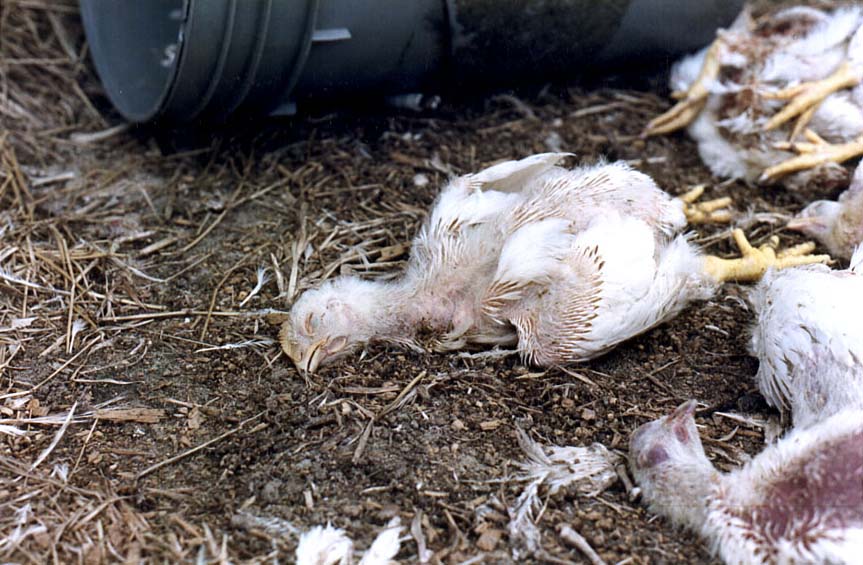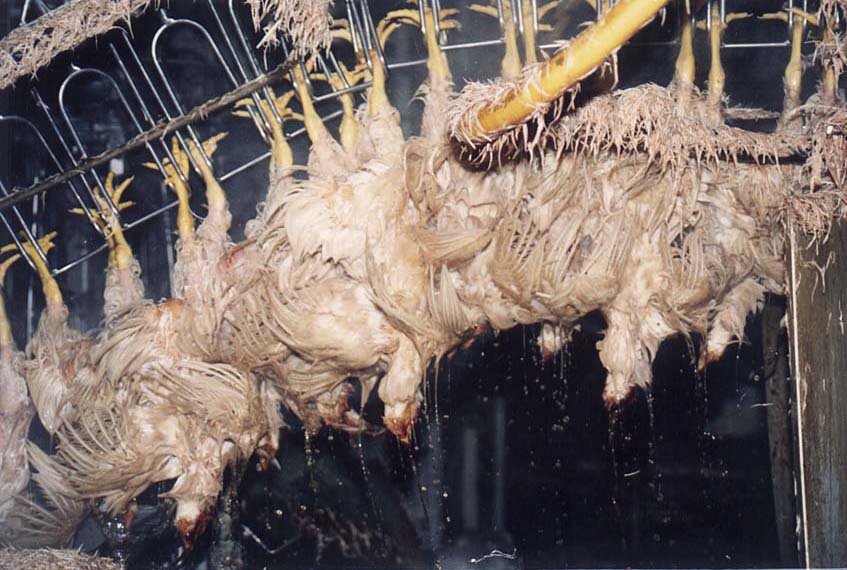Action Alert
Please Write to the National Chicken Council Today!
A "broiler" chicken is essentially an overgrown baby bird, easily hurt, sometimes treated like bowling balls." – Dr. Bruce Webster, American Meat Institute Stunning Conference 2002
A new problem emerged in the poultry industry in the 1990s. An increasing number of reports described broiler breeder males being very aggressive toward females. . . . Because females are being harassed, badly injured, and even killed by males, this is a welfare problem. . . . – Dr. Ian Duncan, Journal of Applied Animal Welfare Science, Vol. 4, No. 3: 207-221.

Photo by Univ of Georgia
Roosters with nasal implants.

Photo by Karen Davis
The National Chicken Council, which represents the "broiler" chicken industry in the United States, is refusing to provide animal welfare standards to the Food Marketing Institute (FMI), which represents retail grocers, and the National Council of Chain Restaurants (NCCR) which represents retail foodservice outlets. PLEASE WRITE TO THE NATIONAL CHICKEN COUNCIL AND ASK WHY THEY HAVE REFUSED TO COME UP WITH MEANINGFUL WELFARE REFORMS to help reduce the misery of "broiler" chickens (the 9 billion baby birds who represent 98% of animals slaughtered for food each year in the United States). Demand reforms.
At a minimum, the chicken industry should stop breeding the birds for fast growth, (which causes painful lameness and heart attacks), give the birds space to move about comfortably, reduce ammonia fumes in the chicken houses, and give the birds something to do, such as green cabbages to peck at. See below for more details.
CONTACT:
George Watts, PresidentNational Chicken Council
1015 15th Street, NW, Suite 930
Washington DC 20005-2605
Ph: 202-296-2622
Fax: 202-293-4005
Email: Gwatts@ChickenUSA.org
Rlobb@ChickenUSA.org (Richard Lobb, Communications Director)
Ammonia Levels. Concentration of toxic excretory ammonia fumes should not exceed 10 ppm (parts per million) at bird level. Higher concentrations harm the birds' immune systems and cause them to develop respiratory diseases and other infections, including painful breast blisters as a result of sitting in ammonia-drenched litter. (Litter is the name for the filthy floor material the chickens are forced to live on-mainly feces and disease organisms).
Forced Rapid Growth of broiler chickens should stop immediately. This includes genetic manipulation for fast growth and the feeding of growth-promoting antibiotics and feed ingredients that cause birds who are full to keep eating. Broiler chickens suffer from severe metabolic and skeletal problems as a result of growing 3 to 4 times faster than normal chickens (Leach, Feedstuffs, Aug. 26, 1996, 10). They suffer from painful lameness and abnormal gaits. Given a choice in scientific studies, these chickens chose foods laced with painkillers (Danbury, Veterinary Record, March 11, 2000, 307-11). Mortality of broiler chickens is 7 times that of laying hens of similar age, and at least 2 percent of broiler chickens die of heart failure, comprising millions of baby birds each year (Turner, Biotechnology and Farm Animals, Compassion in World Farming, 2002, 11-12).

Garrett Seivold
Space Allowance per Bird. Living space per bird should be doubled so that each broiler chicken has at least 1.5 square feet of space (preferably 2 square feet), and each adult chicken used for breeding has at least four square feet of space. The birds need exercise and space for their health and well-being.
Partitions and Perches. Chicken houses should be divided into units holding 80 - 100 birds each, with areas set apart for refuge and rest. Chickens need refuges to correspond to the shelter of the mother hen's wings and the shady areas to which they would normally retreat intermittently during the day in a natural outdoor environment. Broiler chickens and parent flocks should be given perches to satisfy their need to perch and get off the filthy floor.
Activity to Relieve Stress and Boredom. Chickens should be given objects to peck at, to occupy their time and encourage natural pecking behavior and to reduce aggressive behavior in the broiler breeder roosters, including pecking at other birds' heads, which has also been observed in the young birds. Birds would benefit from green cabbages to peck at, which provide activity and nutrients without adding fat. They also need clean dustbathing material to practice hygiene, occupy their time, and encourage normal beak-related behaviors and social activity.
Nasal Implants. The use of the "Nozbonz" in broiler breeder males should be discontinued. The Nozbonz is a 2 ½ inch plastic stick jammed through the nasal cartilage of the young rooster to keep him from poking his head through the food restriction grill and eating the hens' food. (See accompanying photos.). Dr. Suzanne Millman of The Humane Society of the United States writes that "a big welfare problem is the birds getting their heads caught in the grills as a result of the Nozbonz."
She explains that "Nozbonz are not even effective in keeping roosters out of the hens' feeders because roosters try their own experiments to access these feeders. They will turn their heads to get into the grills and, if attacked by other birds, or frightened, they will try to pull back, and panic. They may thus injure or even kill themselves and they sometimes rip the Nozbonz out in the struggle. Instead of the Nozbonz, a slight modification to the feeder grills such as a rubber hose along the top of it prevents males from getting their heads into the hens' feeders."
Gas Stunning. Gas stunning should replace electrical immobilization of birds. The current method of paralyzing conscious birds (instead of stunning them) should stop. Electrically-induced paralysis is surpassingly cruel. Drs. Mohan Raj, Ian Duncan, and others urge that birds should be gas-killed in the transport crates, prior to shackling, with a composition of 60 - 90 percent argon and no more than 2 percent oxygen.
Currently, chickens (and turkeys and ducks) are being deliberately tortured to death with paralytic electric shocks, partial neck-cutting, and, in millions of cases, live scalding. The electric shocks are used to immobilize the birds hanging upside down from the conveyer belts and to paralyze their feather follicles so their feathers come out more easily. Birds are not stunned because the poultry industry claims the high voltage necessary for stunning causes internal hemorrhage producing corpses with pools of coagulated blood in the muscles ("meat").

Photo by Adam Parascandola
Birds in a state of paralytic shock.